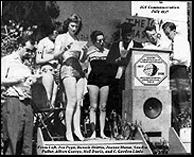Geophysical Institute History "The Beginning" Part 5
"Chapman-Elvey Era," Part 2

International Geophysical Years
During the late 1950s, the Geophysical Institute focused on preparing to participate
in the important International Geophysical Year (IGY), a worldwide 18-month coordinated
project to measure Earth's physical characteristics. Sydney Chapman, GI's scientific director, had previously partaken in the earlier International Polar
Year research in 1932 and was instrumental in creating the IGY.
Chapman as president of the Special Committee for the IGY (CSAGI), arranged for the
World Data Center A to be located at the University of Alaska; other centers were
located in Europe and Russia. University of Alaska received all of the station magnetometer
and all-sky camera data taken worldwide. Thus, the institute later became one of the
two renowned sites (Fairbanks and Moscow) where the important combined data sets are
still available for analysis, see link below.
The institute staff contributed to the IGY by developing several instruments and emplacing
others that had been developed elsewhere, especially from the Stanford Research Institute.
Some of the invented equipment for the IGY were the riometer (Little, Leinbach & Merritt),
all-sky camera (Elvey), and meridian scanning photometer (Clark, Belon, Romick), forthwith
they became highly valued international scientific equipment for many years.

With the arrival of C. Gordon Little and other senior radio-physics people for the
IGY, they had brought the idea for a relative ionospheric opacity meter, or riometer.
Working with Little and his graduate student Harold Leinbach, Robert Merritt of the
electrical engineering department designed the equipment. Riometers determine and
record the level of extraterrestrial radio noise to measure changes in ionospheric
absorption of electromagnetic waves.
Christian (Chris) Elvey, director of the Geophysical Institute, took on the responsibility for developing
an all-sky camera for use by the United States at its many planned observing stations
in the northern and southern hemispheres. All-sky cameras can photograph the entire
sky simultaneously, like a fish-eye lens, to produce multiple images and were used to photograph the aurora. Davis' doctoral dissertation, an analysis
of IGY data, is to this day a classic study of auroral forms.

Another research effort of the IGY was to launch artificial satellites for insight
into the solar-terrestrial relationships. The Soviet Union's research satellite named
Sputnik, carrying a small radio beacon that beeped at regular intervals and could
by mean of telemetry verify exact locations on the earth's surface, was ahead of schedule.
The American effort to launch, code name Project Vanguard, was behind schedule and
over budget. The American spacecraft carried a Geiger counter to measure radiation
encircling the earth. Data from this instrument verified the existence of the Earth's
magnetic field and discovered what came to be called the Van Allen Radiation Belts.
Just as the IGY was starting up, the institute played a fortuitous role in a technical
coup by the Soviet Union. The October 4, 1957 launch of Sputnik was the most exciting
event of the 1950s, the beginning of the space age! The eyes of the Western World
turned skyward and the first scientists to see the new object were graduate students
Robert Leonard and Joseph Pope, with the converted interferometer (radio-telescope)
to a satellite receiver, at the Ballaine Lake Mini-Track Station.

Listening in along with the graduate students were Robert Merritt, Pete Michelow,
Gordon Little, Glenn Stanley, and Ernest Stiltner. According to author and scientist
T. Neil Davis, at least one other person saw the first satellite before any local
scientist. As Davis reports in his book "Alaska Science Nuggets," Dexter Stegemeyer
was the first person known to have seen Sputnik just clearing the western horizon,
when it entered the view through his open outhouse doorway.
During the IGY, Buck Wilson spent 13 months either in or traveling to and from Antarctica.
He was the first person from University of Alaska to journey to Antarctica. Elvey
had arranged for a position at Little America #5 on the Ross Ice Shelf researching
the southern hemisphere's aurora. He used a meridian spectrograph and all-sky cameras
with towers and domes that were heated to room temperature. Wilson, who was appointed
to the faculty in 1963, made ten more trips to Antarctica in future years.
The Geophysical Institute also joined the sea ice research at the Navy's Arctic Research
Laboratory in Barrow (NARL), the first permanent arctic research station, and investigated
two major earthquakes. The Huslia Earthquake April 7, 1958 magnitude 7.3 and Yakutat
Earthquake July 10, 1958 magnitude 7.9, and the latter caused up to 100 foot shoreline
subsidence and cataclysmic waves that killed five people.
The value of the Geophysical Institute participating and the subsequent analysis in
the IGY was significant. Many of the young scientists involved became well known in
the worldwide scientific community, and influenced others who were contributing to
the understandings of solar-terrestrial relationships. Being at the forefront and
instrumental in the beginning of the Space Age, the University of Alaska arrived upon
the worldwide scientific map and gained collegiate recognition.
Geophysical Institute History "The Beginning"
Sources:
American Geophysical Union of the National Academy of Sciences. Antarctica in the IGY. 1958. Geophysical Monograph Number 1. National Research Council.
Davis, T. Neil, Alaska Science Nuggets. Geophysical Institute. University of Alaska, 1982. Fairbanks, AK
Elvey, Chirstian. How to build. operate, organize, & interpret photographic data. The Alaskan All-Sky Camera. IGY 1957 Series. Vol. V. pg. 133-151.
Fitzgerald, Doreen. Institute History: The Elvey-Chapman Years. Geophysical Institute Quarterly Fall 1990.
Odishaw, Hugh. The International Geophysical Year. National Research Council. National Academy of Sciences. Washington, D.C. and actual speech presentation here
Links:
An Expanded Sputnik 1 - Photos by NASA of the history of Sputnik
Geophysical Institute History website here
National Academy of Sciences History website here
Keith B. Mather Library for the Geophysical Institute & International Arctic Research website here
